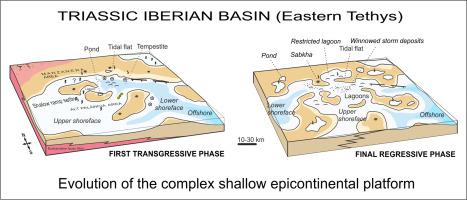Sedimentary Geology ( IF 2.7 ) Pub Date : 2021-04-20 , DOI: 10.1016/j.sedgeo.2021.105904 Alberto Pérez-López , Constantino Benedicto , Federico Ortí

|
Much of the eastern sector of the Mesozoic Iberian basin belongs to the ‘Mediterranean type’ Triassic. This type is characterized by a Middle Triassic stratigraphic record comprised of two carbonate Muschelkalk units (lower and upper) separated by a detrital-evaporite middle Muschelkalk unit. In the present study areas, the two first marine flooding episodes of the Middle Triassic led to the deposition of extensive shallow-water carbonates on a block-controlled epicontinental platform in the lower and upper Muschelkalk units. These carbonates were part of third-order transgressive–regressive sequences. The two carbonate sequences display similar vertical facies and stratigraphic sub-unit arrangements. The base of the two sequences is marked by a (lower) carbonate-marl alternation, which was deposited in mixed tidal flat-to-lagoon settings. In the middle of the sequences, the carbonate character is predominant and facies associations mainly suggest shallow waters and high environmental variability. The change from a transgressive to regressive trend occurs in the middle of the sequences, although the position of the maximum flooding zone can vary from one to another stratigraphic section. The tops of the sequences show two different lithological assemblages, which are coeval and grade laterally to each other. One assemblage is a ‘carbonate terminal complex’ formed by tidal flat and sabkha deposits, which is predominant in the lower Muschelkalk unit. The other assemblage is a lagoon-peritidal (upper) carbonate-marl alternation, predominant in the upper unit. Together, the two sequences suggest a complex platform morphology with a mosaic facies distribution, which evolved from a not very high energy ramp-like profile (transgressive phases, TST) to a lower energy rimmed shelf, ending with tidal/lagoon environments (regressive phases, HST). Facies associations, however, suggest somewhat deeper depositional settings for the upper than lower Muschelkalk unit. Here we compare the two carbonate units in the study areas with those described in the literature from other Triassic basins of Eastern Iberia and the SW Germanic Basin, all forming part of the Peri-Tethys area of the Tethyan Realm.
中文翻译:

伊比利亚东部(特提斯邦西部)中三叠世碳酸盐岩:浅层平台模型
中生代伊比利亚盆地东部大部分地区属于“地中海型”三叠纪。这种类型的特征是由三叠纪中层地层记录组成,该记录由两个碳酸盐Muschelkalk单元(下部和上部)组成,这些碳酸盐Muschelkalk单元由碎屑蒸发中部Muschelkalk单元隔开。在目前的研究区域,中三叠纪的前两次海洋洪水事件导致在Muschelkalk下部和上部Muschelkalk单元的块状控制陆陆平台上大量的浅水碳酸盐沉积。这些碳酸盐是三阶海侵-海退序列的一部分。这两个碳酸盐岩层序显示出相似的垂直相和地层子单元排列。这两个序列的底部以(低级)碳酸盐-泥灰岩交替为标志,该交替沉积在潮汐滩涂至泻湖混合环境中。在这些层序的中间,碳酸盐岩特征是主要的,并且相联系主要表明浅水区和高环境变异性。从海侵趋势向海退趋势的变化发生在层序的中间,尽管最大洪泛区的位置可以在一个地层段之间变化。序列的顶部显示了两个不同的岩性组合,它们是同代的,并且彼此横向平行。一种组合是由滩涂和sabkha沉积物形成的“碳酸盐终端复合物”,该复合物主要出现在下Muschelkalk单元中。另一个组合是泻湖-盆景(上部)碳酸盐-泥灰石交替,主要发生在上部单元中。这两个序列共同显示出具有马赛克相分布的复杂平台形态,它从不太高的能量斜坡状剖面(过渡相,TST)演变成能量较低的有边缘的架子,最终以潮汐/泻湖环境(回归相,HST)结束。但是,相联想表明,上层Muschelkalk单元的沉积环境要深一些。在这里,我们将研究区域中的两个碳酸盐单元与东伊比利亚其他三叠纪盆地和西南日耳曼盆地的文献中描述的碳酸盐单元进行了比较,这些均构成了特提斯地区的佩里-特提斯地区的一部分。











































 京公网安备 11010802027423号
京公网安备 11010802027423号